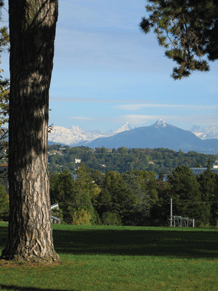Geneva and the Alps: Horace-B?n?dict de Saussure
In the season of avalanches in the Alps and elsewhere, with its escalating toll of human tragedy and death, the work of Horace-B?n?dict de Saussure, Swiss physicist, geologist, meteorologist, and early Alpine explorer comes to the fore. He is described as the most renowned Genevese scholar of the eighteenth century, and the ’founder of climbing’. More than 200 years after his death he is also the subject of a new publication by author Albert V. Carozzi, professor in geology at the University of Illinois, USA (edition Slatkine, Geneva).

Saussure travelled in Germany, Italy and England, wrote extensively and is famous for his monumental four-volumes on Voyages dans Les Alpes (1779-96). A pioneer in the study of mineralogy, botany, geology and meteorology, Saussure’s Travels in the Alps is preceded by an essay on the natural history of the Geneva region, a work recognised as laying the foundations of modern geology and introducing the word geology into the scientific nomenclature.
From 1768 Horace-B?n?dict Saussure began his geological journeys when he crossed the highest mountain range in Europe on fourteen occasions by several routes. The range of the Alps extends some 800 km (497 miles) in an arc roughly East-West through France, Switzerland, Italy and Austria, and rises to 4,807 (15,77l feet) at Mont Blanc near the west end.
Profile in brief
Originally from Lorraine in France, the Saussures came to Switzerland seeking refuge during the Calvin Reformation. As a bourgoise family, the name quickly spread in Geneva and abroad. Its most famous sons were inventor and pioneer Horace-B?n?dict (1740-1799) and Ferdinand (1857-1913).
Born in Conches, near Geneva, on 17 February 1740 Horace-B?n?dict entered the public school at six years old. In 1754 he continued education in the Academy (University) of Geneva. In 1759, aged nineteen, he completed his study at the Academy presenting one Dissertatio physica of igne. In 1762 he became professor of philosophy and natural sciences at the Academy in Geneva (and rector 1774-1775), where he founded the Societe pour l’Avancement des Arts. In 1765 he married Albertine Boissier who is known to have expressed displeasure at her husband’s frequent and protracted absences in his professional and scientific pursuits.
Horace-B?n?dict Saussure is associated with many other inventions or improvements in a wide range of fields and scientific instruments which carry his name. They include a mineral known as Saussurite, and measurements of atmospheric humidity, thermometer, anemometer, hair hygrometer and probably the first electrometer.
Chamonix and Mont Blanc
The name Saussure is synonymously linked to the exploration and conquest of Mont Blanc that made the town of Chamonix famous the world over.
"I couldn’t believe my eyes; it seemed to be a dream when, at my feet, I saw those majestic summits, those awesome peaks …" said by Saussure on his first visit to Chamonix in 1760. He was determined he would climb to the top or be responsible for its being climbed. Saussure offered prize money for the first ascent of Mont Blanc. It was claimed twenty-five years later in 1786 by a Chamonix doctor, Michel-Gabriel Paccard and his porter, Jacques Balmat.
It culminated in Saussure’s own ascent of the Mont Blanc whose summit he reached on 3 August 1787. There he tested the boiling point of water, the temperature of the snow and the pulse of his guides. With a considerable amount of scientific equipment in addition to sustenance for himself and his caravan of eighteen guides, he did not travel light. As well as tents and material, his list of apparel is precisely detailed and lengthy, and his experiments were manifold.
Legacy and sport
Horace-B?n?dict Saussure died at his home in Conches, Geneva, on 22 January 1799 at the age of 59. With other notables, he is buried in the Cemetery of Plainpalais, Rue des Rois, Geneva. In addition to being remembered in Chamonix, there is a commemorative plaque at the place of his former home now named rue de Saussure. He is also remembered with a permanent exhibition at the History of Science Museum, and the College de Saussure, in Geneva.
His experiments and achievements in the Alps are said to have launched mountaineering in the contemporary sporting sense. Cemeteries bear witness to the demise of climbers who, in the footsteps of Horace-B?n?dict Saussure, came from countries and continents in pursuit of the Alpine sport, many of whom stayed for eternity.
Ita Marguet
Note: All sources of information used are acknowledged in the preparation of this article.


